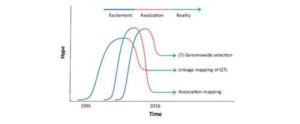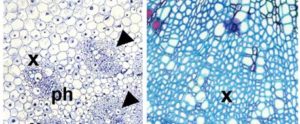A PNAS trio: DNA methylation and small RNAs in plant reproduction
 Three PNAS papers explore DNA methylation and/or small RNAs in plant reproductive development. In angiosperms, sexual reproduction is accompanied by DNA demethylation in certain tissues, particularly those that have a nutritive or supporting role. Park et al. (10.1073/pnas.1619047114) show that in the endosperm this demethylation occurs on the chromosomes inherited from the central cell and requires DEMETER DNA demethylase. By contrast, DNA methylation is maintained in the gametes to ensure transmission of information across the generation. Hsieh et al. (10.1073/pnas.1619074114) show that pollen cells (both sperm cells and vegetative cells) have a greater efficiency of methylation maintenance than somatic cells. Finally, Fan et al. (10.1073/pnas.1619159114) show that photoperiod-sensitive male sterility (an important trait for hybrid seed production) is regulated by phased small-interfering RNAs (phasiRNAs), confirming that the phasiRNAs indeed have biological functions.
Three PNAS papers explore DNA methylation and/or small RNAs in plant reproductive development. In angiosperms, sexual reproduction is accompanied by DNA demethylation in certain tissues, particularly those that have a nutritive or supporting role. Park et al. (10.1073/pnas.1619047114) show that in the endosperm this demethylation occurs on the chromosomes inherited from the central cell and requires DEMETER DNA demethylase. By contrast, DNA methylation is maintained in the gametes to ensure transmission of information across the generation. Hsieh et al. (10.1073/pnas.1619074114) show that pollen cells (both sperm cells and vegetative cells) have a greater efficiency of methylation maintenance than somatic cells. Finally, Fan et al. (10.1073/pnas.1619159114) show that photoperiod-sensitive male sterility (an important trait for hybrid seed production) is regulated by phased small-interfering RNAs (phasiRNAs), confirming that the phasiRNAs indeed have biological functions.


 Trehalose-6-phosphate (T6P) is a sugar signaling molecule that regulates how plants allocate and use sucrose, which in turn affects stress resilience and yields. Griffiths et al. designed a plant-permeable, photo-activated T6P analogue that is converted to T6P in planta. Spraying this compound onto plants (Arabidopsis and wheat) increases stress resilience and yields. These results suggest a novel, non-GM approach to increasing food production. Nature
Trehalose-6-phosphate (T6P) is a sugar signaling molecule that regulates how plants allocate and use sucrose, which in turn affects stress resilience and yields. Griffiths et al. designed a plant-permeable, photo-activated T6P analogue that is converted to T6P in planta. Spraying this compound onto plants (Arabidopsis and wheat) increases stress resilience and yields. These results suggest a novel, non-GM approach to increasing food production. Nature  In this entertaining Opinion article written for the 150th anniversary of Mendel’s seminal work, Bernardo reviews “bandwagons” that have come and gone in plant breeding. Early bandwagons such as induced polyploidy are discussed, as well as more recent trends such as trangenics, molecular markers and QTL mapping, association mapping, and genomewide selection. He also summarizes the life cycle of a bandwagon, and concludes, “Bandwagons come in waves. A plant breeder, just like a surfer, needs to carefully choose which waves to be on.” Theor. Appl. Genet.
In this entertaining Opinion article written for the 150th anniversary of Mendel’s seminal work, Bernardo reviews “bandwagons” that have come and gone in plant breeding. Early bandwagons such as induced polyploidy are discussed, as well as more recent trends such as trangenics, molecular markers and QTL mapping, association mapping, and genomewide selection. He also summarizes the life cycle of a bandwagon, and concludes, “Bandwagons come in waves. A plant breeder, just like a surfer, needs to carefully choose which waves to be on.” Theor. Appl. Genet.  The Journal of Experimental Botany has a special issue on vascular development that features several outstanding review and opinion articles. Topics include Evolution of Conducting Cells, Regulation of Vascular Cell Division, overviews of hormones, peptide signals, receptors and transcription factors in patterning and differentiation, as well as new tools for quantifying secondary growth.
The Journal of Experimental Botany has a special issue on vascular development that features several outstanding review and opinion articles. Topics include Evolution of Conducting Cells, Regulation of Vascular Cell Division, overviews of hormones, peptide signals, receptors and transcription factors in patterning and differentiation, as well as new tools for quantifying secondary growth.